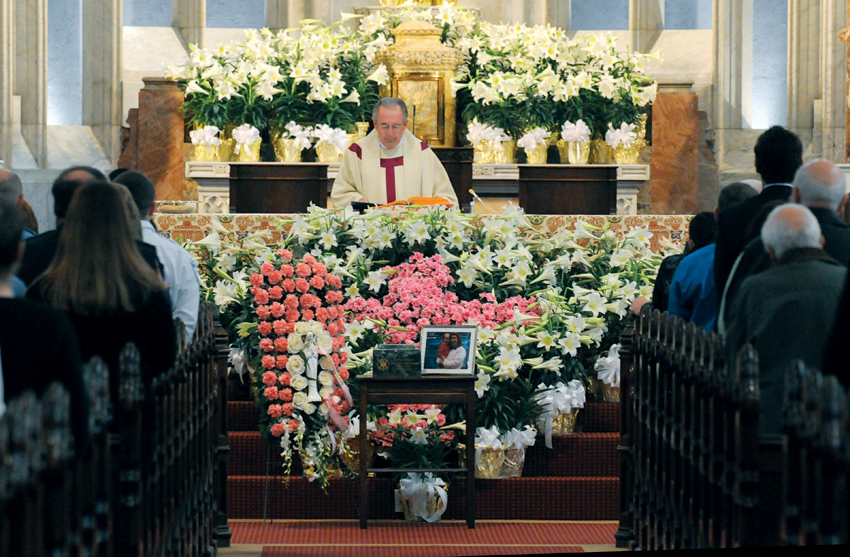Reasonable Doubt: The Cara Rintala Murder Trial

Photo courtesy of The Republican
Taking a step closer to the jurors, Hoose said, “The difference is, I don’t have to prove anything. I don’t have to tell Mr. Gagne all the things that are wrong with his case—although there are many. He, on the other hand, must convince you of Cara Rintala’s guilt beyond a reasonable doubt.” Reasonable doubt, Hoose said, was “the last refuge of the innocent.”
He conceded that Cara should have been considered a suspect, but only along with others, “known and unknown.” There was, for example, Annamarie’s close friend Mark Oleksak, and her former lover, Carla Daniele. Investigators ignored them all, Hoose said, because they were so convinced from the start that Cara Rintala had murdered her wife.
With the opening remarks concluded, the trial began in earnest. Over the next two weeks, Gagne presented the state’s case calmly and methodically. But it soon became apparent that the evidence he had was far less conclusive than he’d claimed at the 2011 bail hearing.
There was, for example, no testimony by other women alleging that Cara had been abusive. (The leads hadn’t panned out, Gagne later said.) Nor was there any discussion of how the paint changed color from pink to white. (Crime-scene photographs taken in the dimly lit basement failed to show the pink color.) As for the rag found in the McDonald’s trash can that state police had claimed had Annamarie’s blood on it, tests showed that DNA taken from the rag was so degraded that no one could say for sure whose blood had stained it, or even if the blood was human.
Gagne’s key witness was Joann Richmond, the medical examiner, by then retired, who had conducted the autopsy. She testified that Annamarie had died of strangulation but had also suffered multiple blunt-trauma injuries and deep cuts on her head, suggesting that she might have been unconscious when strangled. Annamarie also had more than 20 bruises on her arms, legs, and back, injuries consistent with falling—or being pushed—down a flight of stairs.
Richmond testified that if you know where the carotid arteries are—as paramedics do—you can choke someone into unconsciousness within 10 seconds. But it takes another four to four and a half minutes of “throttling” to cause death by strangulation. She now estimated the time of death to be between 11 a.m. and 1 p.m.
During cross-examination by Hoose, though, Richmond conceded that in her original autopsy report, she’d stated that the time of death was “unknown.”
During another cross-examination, a state-police detective told Hoose that Mark Oleksak had lied during his first two interviews with police. Oleksak had first claimed he’d been home all afternoon on the day Annamarie was murdered. When reinterviewed, however, he said he’d gone to a furniture store with his wife and daughter late in the afternoon. Only when confronted with receipts months later did Oleksak acknowledge that earlier that afternoon he’d gone to the bank, to Walmart to buy a pair of sweatpants, and to a Big Y supermarket to buy a bag of cat litter. During the cross-examination, Hoose also brought out the bizarre fact that Oleksak had been so obsessed with Annamarie that after her death he’d brought her sleeping bag home and slept in it for months.
Hoose spent only a day and a half on his defense, as if to show his contempt for the prosecution’s case, which in his opening statement he’d called “a house of cards.” Cara did not testify. Hoose’s most important witness was Elizabeth Laposata, a former Rhode Island state medical examiner and professor of pathology and laboratory medicine at the Brown University medical school. Laposata estimated that Annamarie had died between 2:30 p.m. and 5:20 p.m. In other words, she thought the murder was more likely to have occurred after Cara had left the house than before.
Hoose’s closing argument was simple: The jury could not convict Cara, because the prosecution had not proven her guilt beyond a reasonable doubt. “It’s not my job to convince you that Mark Oleksak committed this murder,” he said. “I don’t know if he did or did not, but he clearly hasn’t been sufficiently investigated.” Why, Hoose asked, did Oleksak buy sweatpants that afternoon? “Were his pants dirty? Were they bloody? We don’t know. The police never tried to find out.”
Oleksak’s purchase of the cat litter, Hoose said, was even more notable. Cat hairs, he pointed out, were found on Annamarie’s body, even though the Rintalas hadn’t owned a cat in at least nine months. “Is that significant?” he asked the jury. “You’ll have to decide. But the evidence suggests that someone who owned a cat or had recent contact with a cat committed this crime.”
When it came time for his closing statement, Gagne told the jury that reasonable doubt does not mean proof beyond all possible doubt. “We don’t need to disprove every wacky theory that the defense throws up against the wall, hoping something sticks,” he said. “The killer must have been covered with cat hair, and Oleksak bought cat litter that day, so he must be the killer?” Common sense, he told the jurors, “is not something you check at the door when you enter that room to deliberate.”
No one would ever know where Cara drove when she was out of range of surveillance cameras, Gagne told the jurors, nor how or where she disposed of the items in the back of her truck. But, he said, it would not be unreasonable to infer that they contained incriminating evidence. And even though there turned out to be no incriminating bloodstains on the rags Cara threw in the McDonald’s trash can, she must have thought there were, otherwise, why discard them?


